Financial Stability Review – October 2018 2. Household and Business Finances
In Australia, financial risks to the household sector remain elevated given the high level of household debt. However, the quality of banks' housing lending has continued to improve in response to tighter lending standards. This is strengthening the resilience of household and bank balance sheets. The changes to lending standards are affecting the borrowers least able to afford a loan but to date have not had a large impact on the supply of credit to most borrowers. Risks in housing markets are evolving as the sector absorbs the impact of tighter lending standards alongside weaker demand, which has been reflected in slower credit growth. Housing market conditions have eased, particularly in Sydney and Melbourne, with a shift in the underlying supply and demand dynamics playing an important role. The easing in prices is small relative to the very large increase in the preceding years and is taking place within a positive macroeconomic environment. However, this adjustment raises some risks – such as possible negative equity for some very recent purchasers, or a reduction in wealth weighing on consumption. A large or rapid correction in housing prices could be disruptive for the financial system and household balance sheets.
The pace of increase in household indebtedness has slowed. In aggregate, households appear well placed to manage their debt obligations, given currently low interest rates and the improvement in lending standards. However, some households are experiencing financial stress, especially in Western Australia. Most households continue to accumulate prepayments, although at a slower pace than in recent years. Household wealth has fallen a little, mainly due to falls in housing prices.
The risks from residential development have eased. These risks arose from the construction of a large number of new apartments. These new apartments are being purchased with only isolated instances of large falls in valuations at settlement compared with the purchase price. Settlement failures remain low. The stock of apartments under construction is lower than it was a couple of years ago. Apartment market conditions remain challenging in Perth, though the size of the Perth apartment market is small relative to the eastern states.
For non-residential commercial property, valuations continue to rise rapidly in the eastern states and yields have fallen further. There is a risk that if these valuations prove unsustainable then price falls could see highly leveraged investors breach their loan covenants. This could trigger sales and further price falls. The risks appear greatest for retail commercial property owners given challenging trading conditions for their tenants. Foreign banks and non-bank lenders have continued to increase their exposures to commercial property, while the domestic banks' exposures have remained steady.
The financial health of the business sector is generally good, supported by positive economic conditions and low interest rates. The resources sector's earnings have increased, consistent with higher commodity prices. However, some sectors are experiencing more difficult conditions. These include the drought-affected agricultural sector in the eastern states, and some bricks-and-mortar retailers in the consumer discretionary sector.
Banks have improved the quality of mortgages
Improvements in the quality of banks' mortgage lending have occurred in response to a range of regulatory measures implemented by the Australian Prudential Regulation Authority (APRA) and the Australian Securities and Investments Commission (ASIC) over recent years (for further detail, see the special chapter, ‘Assessing the Effects of Housing Lending Policy Measures’). Loans with a high loan-to-valuation ratio (LVR), especially those with an LVR exceeding 90 per cent, remain a low share of new lending. The share of new interest-only (IO) lending has fallen sharply to 17 per cent of new loan approvals, well below the regulatory cap. In addition, the stock of IO loans is down by 10 percentage points since June 2017 to just under 30 per cent of outstanding loans. A large number of borrowers have switched their IO loans to principal and interest loans (to avoid the higher interest rates on IO loans).
While the largest changes to lending standards have already occurred, various factors could result in some further adjustments. APRA announced in April 2018 that banks can apply to have the 10 per cent investor lending benchmark lifted subject to meeting certain conditions. Among other things, bank boards will be expected to attest that their lending policies meet APRA's guidance on serviceability and their lending practices will be strengthened where necessary. Bank boards have also been asked to set limits (not prohibitions) on lending with debt-to-income (DTI) ratios exceeding six. This approach recognises that some high DTI lending meets prudential standards and can be justified on a risk basis. The introduction of comprehensive credit reporting over the next 12 months will improve banks' ability to know about all the debt obligations of borrowers. ASIC's recent legal settlement with Westpac on compliance with responsible lending laws may improve understanding about responsible lending requirements for all housing lenders.
The banks, in conjunction with APRA, have been working to improve how living expenses are estimated in loan applications. Banks are scrutinising expenses more closely and this is leading to some loan approvals taking more time. The Royal Commission into Misconduct in the Banking, Superannuation and Financial Services Industry could prompt further changes to lending practices. The cumulative effect of past, and prospective, changes will be to reduce the maximum loan size available to many households. In practice, however, most households will be relatively unaffected since only a small share borrow close to the maximum amount. The prospective borrowers most affected will be those who are least able to afford the loan and these borrowers account for only a small share of new credit. Overall these changes should improve the resilience of borrowers taking out their maximum loan, without having a material effect on aggregate credit availability and growth (See ‘Box B: The Impact of Lending Standards on Loan Sizes’).
Conditions in housing markets have eased
Nationwide, housing prices fell at an annual rate of around 3½ per cent over the six months to September driven mostly by prices in Sydney and Melbourne (Graph 2.1). The largest decline in prices in these cities has been for more expensive properties. Despite the recent price declines, prices in Sydney and Melbourne remain around 50–60 per cent higher than in 2012. In Brisbane, housing prices have been fairly stable over the past year, while conditions in Perth remain weak.
There are a number of demand-side explanations for the recent easing in housing prices. Following the strong price growth between 2012 and 2017, it is not surprising that high price levels have resulted in some moderation in demand. Notably, investors have been less active in housing markets (see the special chapter, ‘Assessing the Effects of Housing Lending Policy Measures’). In addition, demand from foreign buyers has declined because of capital controls in China, as well as new state taxes on foreign buyers. Regulatory measures to improve household and lender resilience are also likely to have reduced access to finance for some riskier prospective purchasers. This may have influenced attitudes towards the housing market.
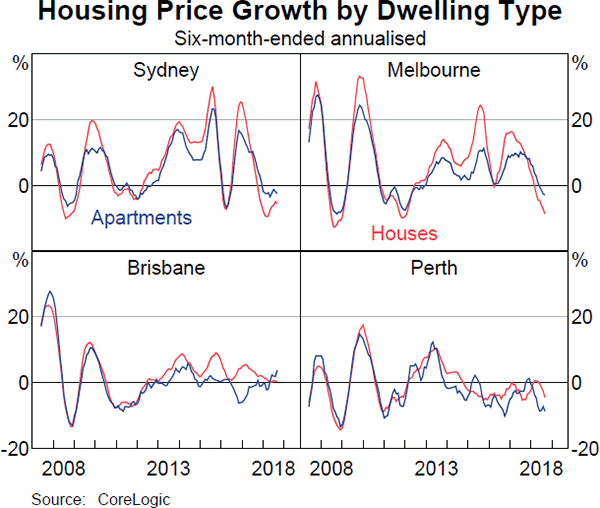
On the supply side, for several years the supply of new housing failed to keep pace with population growth. However, this trend has reversed in recent years and the large supply of new dwellings has also weighed on prices. While price declines have to date generally been moderate, this poses some risks, particularly for off-the-plan apartment purchases. Apartments, especially larger high-rise buildings, have a long planning and development phase, which raises the risk of the housing market weakening between planning and completion.
Earlier concerns about the large increase in the number of apartments in Brisbane and pockets of inner-city Melbourne have receded (Graph 2.2).
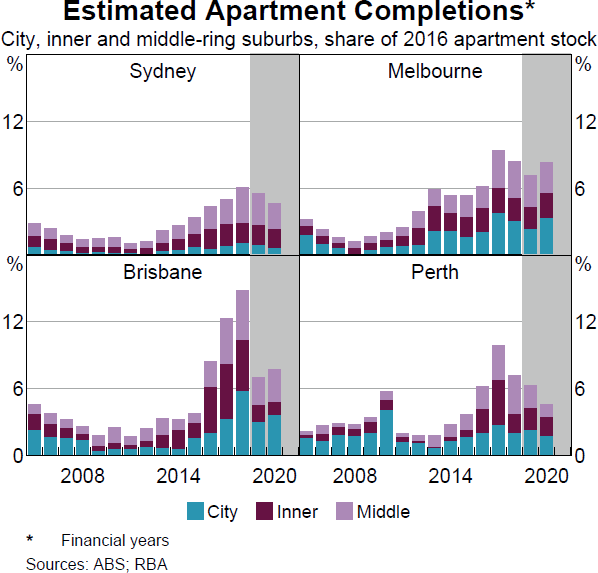
In these cities, the flow of new additions as a share of the apartment stock is around its peak. So far, these new apartments have been absorbed with little change to rents or vacancy rates. Consistent with this, there have not been widespread declines in apartment prices in Brisbane or Melbourne overall, although some parts of these cities have experienced reasonably large price declines (Graph 2.3). There continue to be some reports of settlement delays in Brisbane, with settlement failures mostly isolated to lower-quality developments. There has been a recent substantial increase in new apartments in Sydney although this accounts for a smaller share of the existing stock than in the other east coast cities. The easing in apartment prices in Sydney has been gradual to date. Conditions in the Perth apartment market remain more challenging, but apartments comprise a relatively small share of the Perth housing stock.
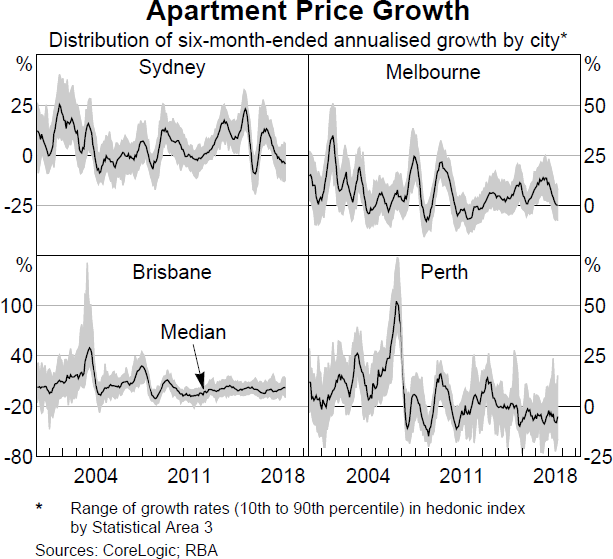
The very high rate of growth of housing prices between 2012 and 2017 was unlikely to be sustained. To the extent that rapid price increases encourage speculation and are associated with rising household indebtedness, a prolonged period of rapid growth can contribute to risks accumulating. The transition to more sustainable housing market conditions also has risks, particularly if a shock accentuates a slowdown and housing prices decline very rapidly. Falling housing prices increase the chance that recent purchasers could see their property value fall below the value of their loan (negative equity). This would make it more difficult for borrowers struggling to repay their loans to resolve the situation by selling the property. Falling housing prices also reduce household wealth, which can weigh on consumption and affect the broader economy. However, the declines in housing prices have not been large enough to have significantly increased these risks.
The near-term outlook for the housing market remains fairly subdued. Auction clearance rates in Sydney and Melbourne remain at low levels. Supply of new housing is expected to exceed population growth for some time, although low or falling vacancy rates and broadly stable rents indicate that new supply is generally being absorbed without disruption (Graph 2.4). If adverse sentiment towards the housing market were to build and the economy were subject to a shock, there would be a small risk that escalating or rapid price declines could prompt more selling, particularly by investors, and hence lead to further falls.
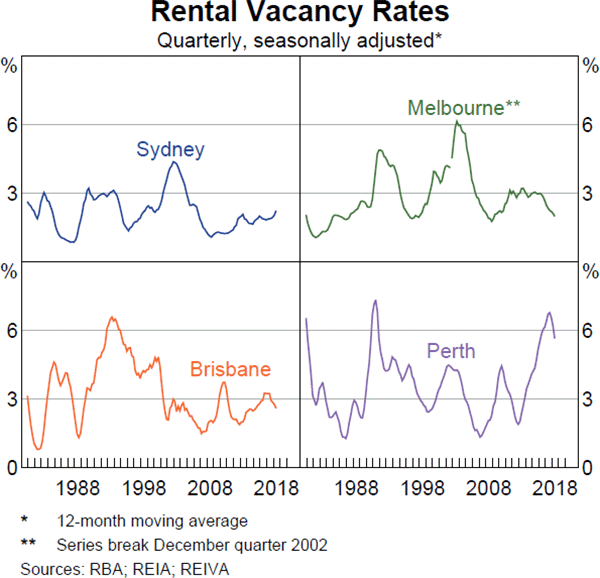
The household debt-to-income ratio has continued its upward drift
The increase in household debt over the past few years has been largely driven by owner-occupier housing debt. In contrast, investor housing debt has been fairly flat relative to income (Graph 2.5). Notwithstanding the recent moderation in the growth of debt and change in its composition, households' high outstanding stock of debt remains a concern. Households with a high debt burden could cut back on their spending if economic conditions were to deteriorate.
For almost all households, the value of their assets greatly exceeds the value of their debt (Graph 2.6). However, for most households, almost all of their wealth is in relatively illiquid assets, such as housing and superannuation. An individual household can ultimately sell their house if they have trouble making repayments. However, this would have wider negative implications if repayment difficulties were widespread, if unemployment were to rise substantially, and if many households needed to sell at once. Further, asset prices can experience large falls while the debt underpinning those assets is fixed, and so there are risks associated with relying on rising asset values to meet debt obligations.
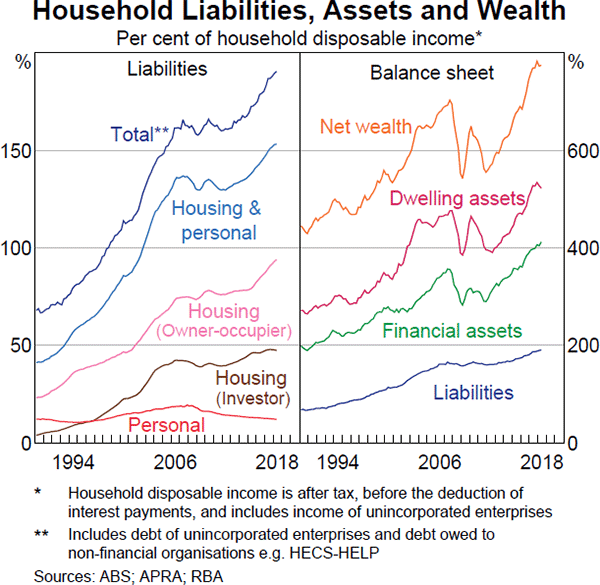
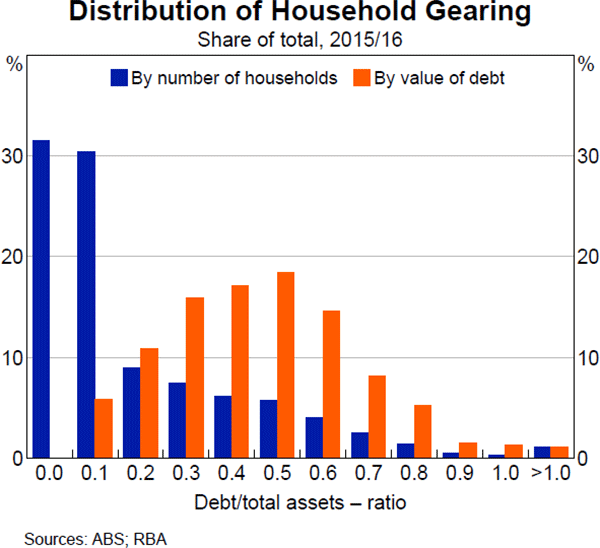
At present, households in aggregate appear well placed to manage their debt repayments. Total payments as a share of income have remained broadly in line with their levels over recent years. Within this, scheduled principal repayments have increased, while unscheduled payments (into offset accounts and redraw facilities) as a share of income have fallen (Graph 2.7). The increase in scheduled payments is partly due to households switching from IO to principal and interest loans. Although households have so far maintained their mortgage repayments as a share of income, this has coincided with a marked decline in an aggregate measure of the household saving rate as income growth has slowed.
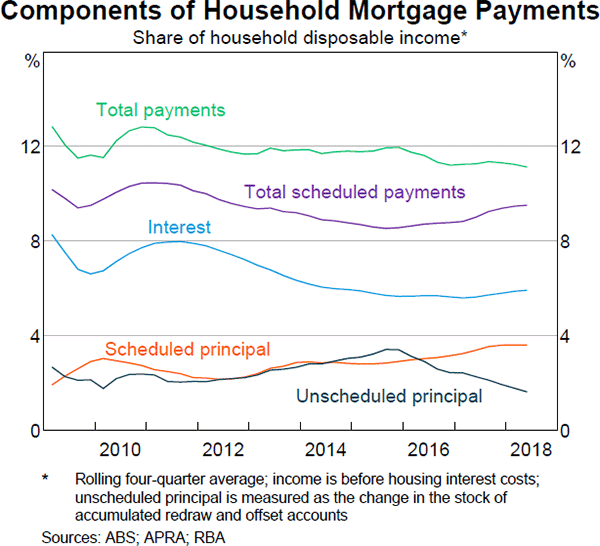
While households are saving and accumulating their prepayments at a slower pace, the stock of mortgage prepayments is substantial. But with unscheduled mortgage payments falling relative to income, the stock of prepayments is increasing more slowly than a few years ago. It currently amounts to 18 per cent of outstanding mortgages or nearly three years of scheduled repayments. The distribution is uneven, with around one-third of borrowers having over two years' worth of prepayments while one-third have less than one months' worth (Graph 2.8). Of these, a sizeable proportion are fixed rate or investor loans that do not provide borrowers with the same incentives or ability to make prepayments. Some are new loans, which have had less time to accumulate prepayments. There may also be borrowers with low levels of prepayments who are not vulnerable because they have other assets.
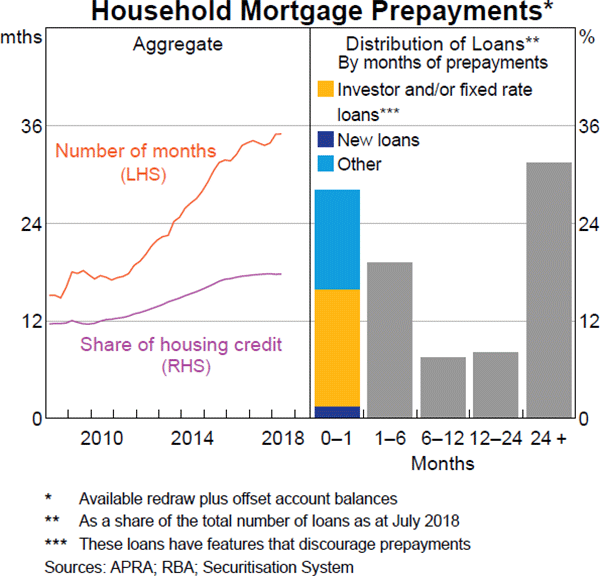
Reliable and relatively timely indicators point to pockets of household financial stress, but this is not widespread. In 2016, around 5 per cent of indebted owner-occupiers spent more than 30 per cent of their after-tax income on required debt repayments and were in the lowest 40 per cent of the income distribution in 2016. These households are more likely to report financial stress and fall behind on their repayments (see ‘Box C: Vulnerable Households and Financial Stress’). Indicators of financial stress are higher in Western Australia and the mining regions of Queensland. Bankruptcies in Western Australia are rising and are higher than in the rest of Australia. These regional variations are also evident in rates of non-performing loans (see ‘The Australian Financial System’ chapter).
Yields on prime commercial property assets have continued to fall
Yields on commercial property are now very low by historical standards, as growth in commercial property values has continued to outpace rents (Graph 2.9). This has occurred despite a slight increase in long-term interest rates over the past six months. It has resulted in further compression of the spread between returns on commercial property investments and long-term risk-free assets (Graph 2.10). This yield compression has been evident across office, industrial and retail markets. One contributor could be the long lead-time in commercial property projects, meaning supply can be slow to respond to investor demand. It could be that the demand to own commercial property exceeds projected tenant demand, for example, if investors view commercial property as offering a more attractive return relative to the low yield on many other assets. This would lead to an increase in property values that is not matched by rising rents, thus lowering yields on commercial property assets. There is some support for this hypothesis from the fact that recent transaction prices have exceeded estimated valuations based on existing rental yields. In liaison, banks have noted that the current low yields pose risks to the commercial property sector. If transaction prices and estimated valuations were to adjust downward – for example, in response to increases in global interest rates – highly leveraged borrowers could be vulnerable to breaching their LVR covenants on bank debt, which could potentially trigger property sales and further price declines.
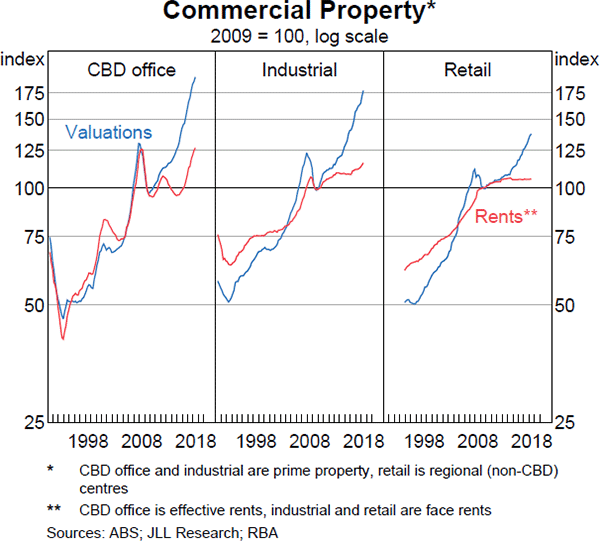
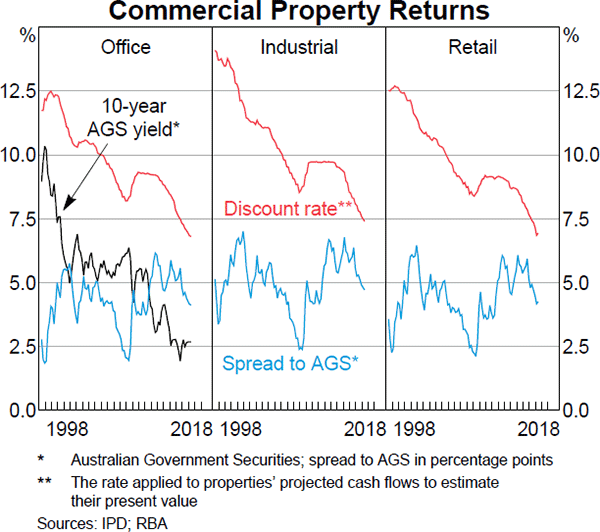
Conditions in established commercial property markets continue to vary significantly across states. Investor demand remains particularly strong in the Sydney and Melbourne office markets. Limited net new supply over recent years, in conjunction with robust tenant demand, has driven vacancy rates to near historic lows (Graph 2.11). The recent strength in the rate of price growth for office buildings has elicited a supply response from developers, particularly in Sydney's middle-ring suburbs (e.g. Parramatta and Macquarie Park) and in inner-city Melbourne, although it is possible that some of these projects will not be constructed (Graph 2.12). Although some of these developments have tenancy pre-commitments, others are being built with little or no pre-committed tenancies. If these new additions with relatively few pre-commitments were to be completed in a deteriorating market, they may struggle to attract tenants at their anticipated rental yield, which could in turn lead to further valuation declines. In Brisbane, Perth and Adelaide, elevated office vacancy rates and declining rents continue to motivate tenants to relocate into better quality space in these cities' CBDs. This has pushed vacancy rates higher in second-grade and non-CBD office buildings, where the outlook remains weak.
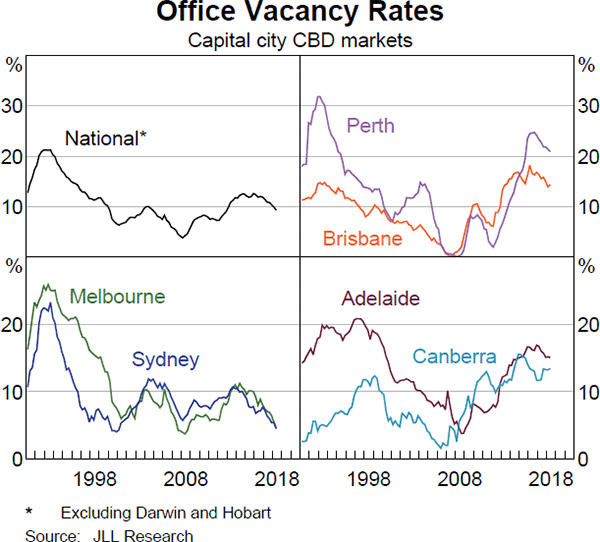
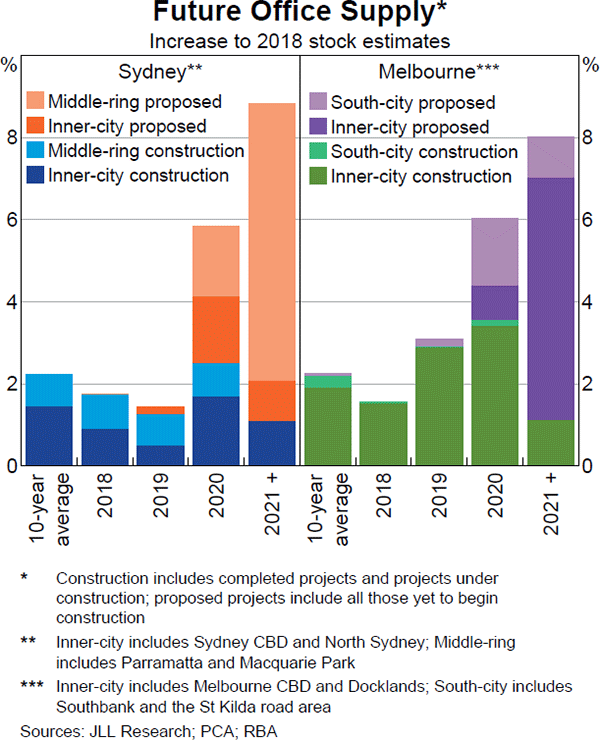
Conditions in retail property markets remain challenging. Face rents (which exclude the value of incentives such as rent-free periods) have been flat for five years, with some retailers finding it difficult to accommodate rent increases amid challenging trading conditions. In addition, liaison suggests that shopping centre owners have offered significant incentives – such as rent-free periods and store fit-outs – to attract tenants. The combination of unchanged face rents and growth in incentives suggests that net income for some shopping centre owners could be declining. Despite these challenges, banks have continued to fund the refurbishment and expansion of shopping centres as owners attempt to respond to intense competition from online retailers by increasing their service and hospitality offerings.[1]
Banks have increased their exposures to office property
The growth in banks' office property exposures has continued to outpace their other commercial property portfolios (Graph 2.13). However, this growth in office exposures has continued to be driven by foreign-owned banks, with the major Australian banks' exposures remaining unchanged (Graph 2.14). Consistent with the challenging environment for retailers, liaison indicates that the major banks have reduced their willingness to lend to retail property investors.
For residential development, apartment developers' access to bank finance has remained tight and in some cases been tightened further. In response, an increasing number of developers are now seeking finance from non-bank lenders at significantly higher interest rates, in exchange for easier credit terms such as lower pre-sales requirements and/or LVRs. An increase in non-bank financing could increase financial stability risks if banks were to respond to this competition by loosening their lending standards or if it enabled a large increase in supply that weakened apartment market conditions. To date there is no evidence of this occurring.
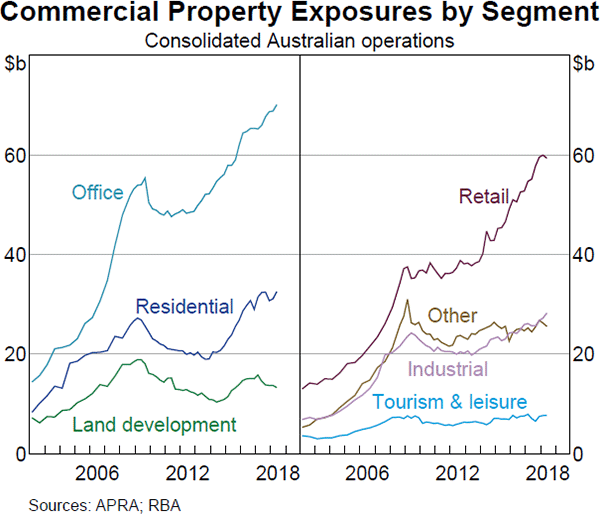
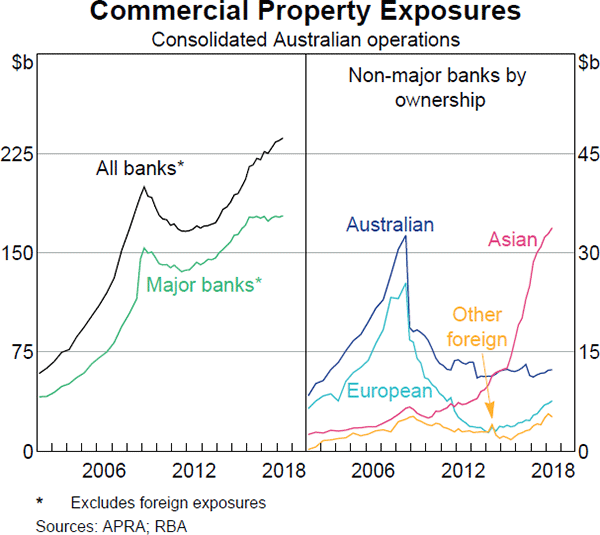
Business finances generally remain in good shape
Financial conditions for businesses continue to be supported by positive economic conditions and the low interest rate environment.
Businesses' ability to service their debts improved over the first half of 2018 supported by higher profits. Aggregate earnings of listed companies rose across most industries compared to the first half of 2017 (Graph 2.15). In contrast to many major economies, the gearing ratios of listed Australian businesses have typically declined over recent years and are generally sitting at low levels.
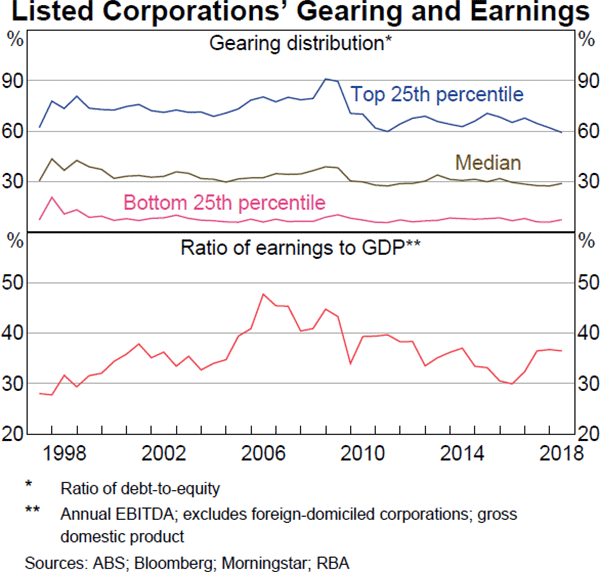
The broadly favourable conditions for businesses have been reflected in strong earnings growth in a number of sectors. Earnings of listed resource companies increased in the first half of 2018 compared with the first half of 2017, largely driven by increases in commodity prices. Businesses in the technology and utilities sectors have also experienced relatively strong earnings growth over the same period. Although the agricultural sector is facing challenges from the drought conditions in the eastern states, and many farmers are facing reduced incomes, agricultural businesses appear well placed overall to meet their debt obligations. Deposits held by primary producers under the Farm Management Deposit Scheme are at relatively high levels and have not seen significant outflows to date. Deposits held under this scheme are able to be withdrawn under certain circumstances, including in the event of severe drought. Bricks-and-mortar retailers in the consumer discretionary sector continue to be challenged by increased competition from international and online retailers, slow growth in consumer spending and changing consumer preferences. Nevertheless, aggregate gearing and debt-servicing ratios for companies in these more challenged sectors remain at low levels to date.
Footnote
For more information, see Araujo G and T De Atholia (2018), ‘Financial Stability Risks and Retailing’, RBA Bulletin, September. [1]